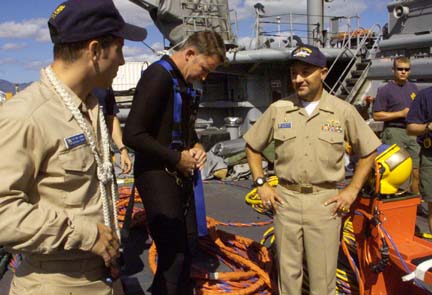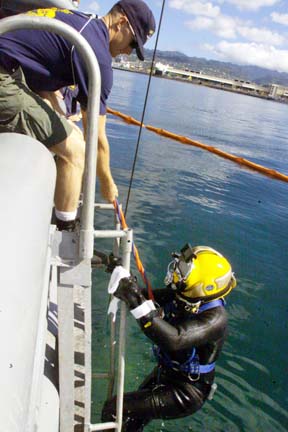


Unexpected event Lt. j.g. Alex Leanos had hoped to spend a quiet Friday afternoon in February at Sandy Beach relaxing in the surf before his ship, the USS Salvor, was to leave Pearl Harbor to tow a vessel to San Francisco.
leads to historic
Navy assignment
USS Salvor dives deep
for Ehime Maru jobAT YOUR SERVICE
FOR YOUR BENEFITBy Gregg K. Kakesako
gkakesako@starbulletin.com"I was looking forward to a long weekend which is (usually) the case before we get under way," said Leanos, the rescue salvage ship's operations officer. "Then I got a call on my cell phone recalling me to the ship. I got on my motorcycle, but by the time I got here (Pearl Harbor), the Salvor was already in the channel."
Along with several other crewmen from Salvor, Leanos hitched a ride on a small boat to the rescue vessel and for the next four days was part of an extensive search for the nine men and boys who were swept overboard when the Japanese training vessel Ehime Maru was struck by the nuclear attack submarine USS Greeneville. The Salvor covered more than 400 square miles from Feb. 9-12.
The 255-foot Salvor was the first Navy vessel to reach the collision site nine miles south of Diamond Head on Feb. 9 and next month it will be the last one to mark the Ehime Maru's final resting point 12 miles off Kalaeloa.

"It will be our job to place two pinger detectors marking the final relocation site," said Lt. Cmdr. John Carter, the Salvor's commanding officer.Since Feb. 9, the Salvor and its team of 15 divers have been part of the Navy's Ehime Maru operations, including the first search for the victims and the ship itself, the lift and movement of the Ehime Maru to the recovery site near the Honolulu Airport, the dives into the ship's compartments, and finally its upcoming relocation in international waters.
The 15-year-old Salvor is the third ship in the Safeguard class of rescue salvage ships.
Carter said the Salvor's sister ships, Grasp and Grapple, were involved in the 1996 TWA flight 800 rescue operations and the recovery mission in the 1999 Egypt Air flight 990 crash.
Carter said Salvor, with only 80 percent of its crew of 110 aboard, was under way 90 minutes after the collision between the Greeneville and the Ehime Maru occurred at 1:45 p.m. Setting up a grid pattern, the Salvor searched the collision area plucking up personal items from the ocean and serving as the Navy's on-scene command vessel, he said.
On Feb. 17, Carter said the Salvor's mission changed with the addition of a team of salvage experts from Maryland, a remotely operated vehicle and side-scanning sonar. "Our job was to recover any personal effects off the ocean bottom and to map the site, where the Ehime Maru sank."
Last month when the civilian exploratory vessel Rockwater 2 raised and then moved the Ehime Maru to the reef runway shallow-water recovery site, the Salvor provided security for the operations. Its remotely operated vehicle scoured the ocean bottom for anything that might have fallen from the Japanese vessel.
"Nothing fell off the Ehime Maru during the transit," Carter said.
Once the Ehime Maru was safely deposited in 115 feet of water on Oct. 15, the Salvor returned to Pearl Harbor.
However, Carter said about seven divers remained on the Crowley 450-10 diving barge to participate in the recovery operations while other crewmen manned the small security boats that patrolled the dive area. The Navy exceeded its expectations when its divers recovered the bodies of eight of the nine missing men and boys.

Salvor's master diver Tom Perkins said his vessel's final role will be to cut down the two mooring pylons at the reef runway recovery site which were used to moor the diving barge. Divers also will make a video survey of the recovery site to ensure that nothing is left behind.Even with the increased work, Carter said the Salvor had the highest retention rate of first-term sailors at Pearl Harbor. "Seventy percent of our first-termers were staying in," Carter said.
The Salvor's galley is considered one of top three among the small ships in the Hawaii region and Leanos was picked as the junior ship handler of the year.
Achievements such as these make fireman apprentice Jericho Diego, a 2000 Lahainaluna High School graduate, feel "lucky" he was assigned to the Salvor. "I went to school to be a diesel mechanic and this is a perfect ship for my rating."